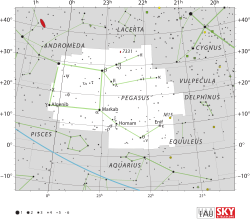Gamma Pegasi
| Observasjonsdata Epoke J2000 Ekvinoks J2000 | |
|---|---|
| Stjernebilete | Pegasus |
| Rektascensjon | 00h 13m 14.15123s[1] |
| Deklinasjon | +15° 11′ 00.9368″[1] |
| Tilsynelatande storleiksklasse (V) | +2.84[2] |
| Karakteristikk | |
| U−B fargeindeks | –0.85[2] |
| B−V fargeindeks | –0.23[2] |
| Variabel type | β Cep[3] |
| Astrometri | |
| Eigarørsle (μ) | RA: +1.98[1] mas/år Dek.: –9.28[1] mas/år |
| Parallakse (π) | 8.33 ± 0.53[1] mas |
| Avstand | 390 ± 20 ly (120 ± 8 pc) |
| Detaljar | |
| Masse | 8.9 ± 0.1[4] M☉ |
| Radius | 4.80 ± 0.39[5] R☉ |
| Luminositet | 5,840[6] L☉ |
| Overflategravitasjon (log g) | 3.98 ± 0.06[5] cgs |
| Temperatur | 21,179 ± 237[5] K |
| Metallisitet [Fe/H] | –0.34[7] dex |
| Rotasjonssnøggleik (v sin i) | 0[8] km/s |
| Alder | 18.7 ± 3.2[4] mill. år |
| Andre namn | |
Gamma Pegasi (γ Peg) eller Algenib er ei stjerne i stjernebiletet Pegasus, i nedre venstre hjørne av asterismen Den store firkanten. Det tradisjonelle namnet Algenib er òg eit anna tradisjonelt namn for Mirfak. Den tilsynelatande storleiksklassen er +2,84[2] som gjer ho til den fjerde mest lyssterke stjerna i stjernebiletet. Avstanden frå jorda er kring 390 lysår med ein feilmargin på 5 %.[1]
Stjerna er stor med nesten ni[4] gonger solmassen og nær fem[5] gonger solradien. Spektralklassen B2 IV[4] indikerer at ho er ei subkjempestjerne som er i ferd med å brenne opp hydrogenet i kjernen og utvikle seg bort frå hovudserien.[8] Gamma Pegasi har ein total luminositet på 5 840 gonger sola sin,[6] med ein effektiv temperatur i den ytre atmosfæren på meir enn 21 000 K.[5] Med denne temperaturen har stjerna ein blåkvit farge.[10]
Kjelder[endre | endre wikiteksten]
- Denne artikkelen bygger på «Gamma Pegasi» frå Wikipedia på engelsk, den 29. august 2014.
- Wikipedia på engelsk oppgav desse kjeldene:
- ↑ 1,0 1,1 1,2 1,3 1,4 1,5 van Leeuwen, F. (November 2007), «Validation of the new Hipparkos reduction», Astronomy and Astrophysics 474 (2): 653–664, Bibcode:2007A&A...474..653V, arXiv:0708.1752, doi:10.1051/0004-6361:20078357
- ↑ 2,0 2,1 2,2 2,3 Crawford, D. L.; Barnes, J. V.; Golson, J. C. (1971), «Four-color, H-beta, and UBV photometry for bright B-type stars in the northern hemisphere», The Astronomical Journal 76: 1058, Bibcode:1971AJ.....76.1058C, doi:10.1086/111220
- ↑ Walczak, P.; Daszyńska-Daszkiewicz, J. (December 2010), «Complex asteroseismology of the hybrid B-type pulsator γ Pegasi: A test of stellar opacities», Astronomische Nachrichten 331 (9/10): 1057–1060, Bibcode:2010AN....331.1057W, arXiv:1004.2366, doi:10.1002/asna.201011456
- ↑ 4,0 4,1 4,2 4,3 Tetzlaff, N.; Neuhäuser, R.; Hohle, M. M. (January 2011), «A catalogue of young runaway Hipparkos stars within 3 kpc from the Sun», Monthly Notices of the Royal Astronomical Society 410 (1): 190–200, Bibcode:2011MNRAS.410..190T, arXiv:1007.4883, doi:10.1111/j.1365-2966.2010.17434.x
- ↑ 5,0 5,1 5,2 5,3 5,4 Fitzpatrick, E. L.; Massa, D. (March 2005), «Determining the Physical Properties of the B Stars. II. Calibration of Synthetic Photometry», The Astronomical Journal 129 (3): 1642–1662, Bibcode:2005AJ....129.1642F, arXiv:astro-ph/0412542, doi:10.1086/427855
- ↑ 6,0 6,1 Hohle, M. M.; Neuhäuser, R.; Schutz, B. F. (April 2010), «Masses and luminosities of O- and B-type stars and red supergiants», Astronomische Nachrichten 331 (4): 349, Bibcode:2010AN....331..349H, arXiv:1003.2335, doi:10.1002/asna.200911355
- ↑ Gies, Douglas R.; Lambert, David L. (March 10, 1992), «Carbon, nitrogen, and oxygen abundances in early B-type stars», Astrophysical Journal, Part 1 387: 673–700, Bibcode:1992ApJ...387..673G, doi:10.1086/171116
- ↑ 8,0 8,1 Abt, Helmut A.; Levato, Hugo; Grosso, Monica (July 2002), «Rotational Velocities of B Stars», The Astrophysical Journal 573 (1): 359–365, Bibcode:2002ApJ...573..359A, doi:10.1086/340590. The zero value is for v sin i, so v and/or i must be small.
- ↑ «gam Peg -- Variable Star of beta Cep type», SIMBAD Astronomical Object Database (Centre de Données astronomiques de Strasbourg), henta 23. februar 2012
- ↑ «The Colour of Stars», Australia Telescope, Outreach and Education (Commonwealth Scientific and Industrial Research Organisation), December 21, 2004, arkivert frå originalen 3. desember 2013, henta 16. januar 2012

